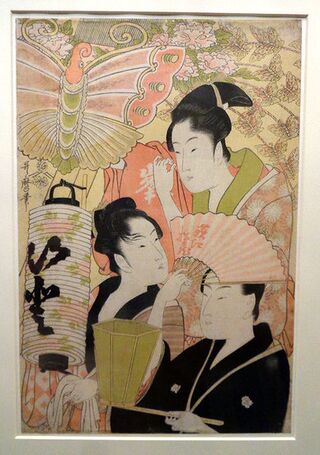Difference between revisions of "Niwaka"
| Line 1: | Line 1: | ||
| + | [[File:Niwaka-utamaro.jpg|right|thumb|320px|Niwaka performers, in a woodblock print by [[Utamaro]], [[1793]]]] | ||
*''Japanese'': 俄 or 仁和嘉 ''(niwaka)'' | *''Japanese'': 俄 or 仁和嘉 ''(niwaka)'' | ||
Revision as of 07:26, 13 August 2016
- Japanese: 俄 or 仁和嘉 (niwaka)
Niwaka were amateur farcical plays popular from the early 18th century onwards; closely based on professional kabuki plays of the time, niwaka performed by courtesans of the Yoshiwara were particularly popular, and sometimes depicted in ukiyo-e prints.
In Edo, niwaka performances by courtesans came to be a regular annual event in the Yoshiwara; they were performed in the 8th month each year, as part of a festival dedicated to the kami Inari. The festival also involved a parade through the Yoshiwara, in which courtesans in various costumes rode on floats, and stopped at teahouses to perform skits and dances.
Similar performances, called Gion nerimono, also took place annually in Kyoto, in conjunction with Gion Matsuri. Niwaka prints produced in Kyoto included not only those made in the standard woodblock manner, but also kappazuri (stencil) prints.
References
- Matsuba Ryoko, "Niwaka prints: a window into the relationship between publishers, patrons, courtesans and kabuki in Edo and Kyoto," Kabuki Symposium, University of Hawaii at Manoa, 13 November 2010.
- "Tongue in Cheek: Erotic Art in 19th-Century Art," Honolulu Museum of Art, exhibition website, accessed 1 December 2014.
